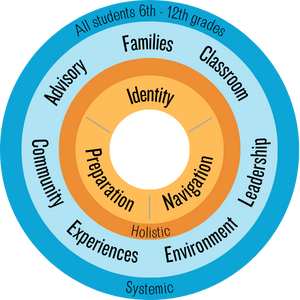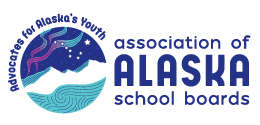Helping Students Prepare for Life After High School
Why does it matter?
When students have a plan for life after high school – whether career or military training or two-year or four-year college programs – they are better able to contribute to their community and more likely to thrive.
Unfortunately, Alaska has among the lowest rates of postsecondary attainment in the nation and high rates of disconnected youth: one in five young adults in Alaska (ages 16-24) is not engaged in school or work, according to the Measure of America. Our communities and employers need the next generation to be ready to step into leadership roles, and our young adults need a sense of purpose and connection.
How Can AASB Help?
AASB has been taking a close look at why Alaska’s postsecondary outcomes are far lower than other states and how we can improve those outcomes.
- The Alaska College and Career Guidance Interviews & Findings Report takes a closer look at how career guides and advisors are making a difference for Alaska’s students.
- The Bridging to the Future Framework can help school leaders inventory their school district’s postsecondary strengths and gaps.
Research finds that students thrive when school districts take a systemic and holistic approach to supporting postsecondary preparation. Schools can help students prepare for life after high school by fostering academic preparation, postsecondary and life navigation skills, and cultural and self-identity.
In the fall of 2022, AASB teamed up with the Alaska Postsecondary Completion and Access Network (Alaska CAN) to host a statewide convening on what we can do Now to help prepare students for what’s Next. Over one hundred Alaskans from all corners of the state came together during the Now for Next workshop to make recommendations which include:
- Embed culturally affirming social & emotional learning
- Identify key timelines & provide financial literacy support for families
- Start early (no later than middle school)
- Fund career guides (coaches & advisors) to support students in making a plan
- Foster mentorships at the community and campus levels
Did You Know?
College and Career Readiness is a goal of both Alaska’s Education Challenge and Healthy Alaskans 2030!
For more about how school boards can monitor and support postsecondary success of their graduates, see the January, 2024 Commentary article, Are your students ready for life after high school?


More funding is available for Alaskan students (if they know how to access it.)
Alaskan students are now eligible for up to $28,000 from the Alaska Performance Scholarship. In 2024 the Alaska legislature increased the amount of money available to students for this merit-based scholarship and changed eligibility requirements. Here’s what you need to know:
- Students must take a qualifying high school curriculum.
- Schools are required to inform students about their eligibility for the scholarship.
- The amount of funding available depends on a student’s Grade Point Average.
- Test scores (SAT, ACT or Workkeys) are optional and can be used to determine how much money a student is eligible to receive instead of their GPA.
Qualifying curriculum
School boards and administrators should review their curriculum and schedules to ensure students can access the Alaska Performance Scholarship. Some school districts align their graduation requirements to meet the scholarship requirements.
Eligible courses are outlined in the state statute, however, districts may offer substitute courses that are considered rigorous.
For example, Bering Strait School District recently identified qualifying APS courses in their catalog. Administrators determined that their Siberian Yup’ik class met the requirement for rigor while other Intro to Yup’ik classes did not yet meet that standard.
Some smaller schools in Bering Strait don’t currently offer enough stand-alone science courses for students to qualify for the scholarship. Instead, the district is partnering with the university to offer dual enrollment science credit options.
School boards and administrators can help teachers, counselors, students, and families plan for the scholarship by:
- Creating and sharing a list of APS-eligible courses offered by the district and its partners.
- Providing families and students with support to complete the Free Application for Federal Student Aid. The FAFSA serves as the application for the Alaska Performance Scholarship.
- Ensuring faculty and staff have the training and resources necessary to educate the school community about the Alaska Performance Scholarship.
The Alaska Commission on Postsecondary Education has more information on eligibility requirements, FAQs, FAFSA completion support, and additional info on its website. Felicia Swanson at the Department of Education & Early Development, felicia.swanson@alaska.gov can help with eligibility questions for the scholarship.
Informing students (and their families)
Another change in the legislation requires schools to make students aware of the opportunity during their 9th and 10th grade years. We recommend also sharing information with 8th grade students and their families so they can plan ahead and stay motivated to keep their GPA high.
Additionally, schools must let 11th grade students know about all remaining course requirements and GPA or test scores needed to be eligible for the Alaska Performance Scholarship. Again, keeping families in the loop helps strengthen the web of support for students.
Here are some examples to help you get started:
- Four-year course planning examples to use with students and families.
- Sample email to families
Other scholarships
Don’t forget to let your students know about the many other scholarships that are also available like AASB’s June Nelson Scholarship. Each year the Ciri Foundation publishes a robust list of scholarships. Many of these can be used to help cover expenses like books or travel to and from school in addition to tuition.
Tracking your district’s progress
With the new Alaska Performance Scholarship legislation, legislators hoped to increase the number of students who are aware of the Alaska Performance Scholarship and its overall utilization. In 2023, only 17% of the state’s students were eligible, and only a third of those students used the scholarship. You can see how many students in your district were eligible and used the scholarship in Appendix B of the Annual Alaska Performance Scholarship report.
When standardized testing was removed as an APS requirement during the pandemic, the rate of Alaskan students eligible for the scholarship nearly quadrupled to 61%. Keep an eye out for the Annual Alaska Performance Scholarship report in future years to monitor your district’s progress. If we succeed in offering eligible curriculum statewide and communicating the opportunity with students and families, we anticipate every district will see a jump in scholarship eligibility and use. That’s an excellent outcome for both our students and our state.
Workshops
In addition to the reports and resources listed on this page, AASB can facilitate workshops with school boards, staff, and community members to assess your postsecondary outcomes and develop strategies to help more students transition to meaningful opportunities after high school.
To learn more about these workshops and other resources, contact Emily Ferry, eferry@aasb.org.
